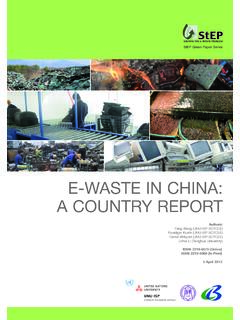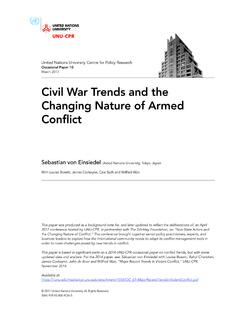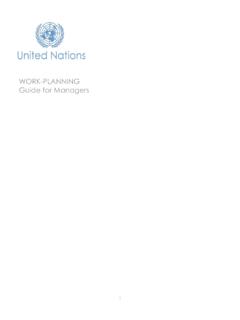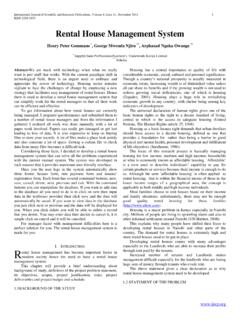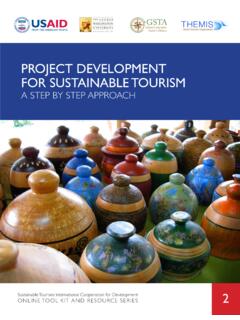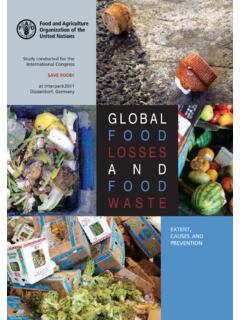Transcription of TUVALU: CLIMATE CHANGE AND MIGRATION
1 tuvalu : CLIMATE CHANGE AND MIGRATIONRELATIONSHIPS BETWEEN HOUSEHOLD VULNERABILITY, HUMAN MOBILITY AND CLIMATE CHANGEREPORT NO. 18 November 2016 ANDREA MILAN, ROBERT OAKES AND JILLIAN CAMPBELL This report should be cited as:Milan, A., Oakes, R., and Campbell, J. (2016). tuvalu : CLIMATE CHANGE and MIGRATION Relationships between household vulnerability, human mobility and CLIMATE changeReport Bonn: United nations University Institute for Environment and Human Security (UNU-EHS).UNITED nations UNIVERSITYI nstitute for Environment and Human Security (UNU-EHS)UNU-EHS PUBLICATION SERIESNOVEMBER 2016 REPORT NO. 18 Table of contents Acknowledgements ..5 Acronyms ..6 Glossary ..7 Executive summary ..9 Key Findings ..11 Policy Implications and Recommendations ..131. Background .. CLIMATE CHANGE and MIGRATION : global context .. Framework of study ..192. Country context.
2 Physical geography and environment .. CLIMATE CHANGE projections for tuvalu .. Demographics .. Socio-economic context .. Gender .. MIGRATION within and out of tuvalu .. Remittances ..293. Methodology .. Household survey .. Qualitative analysis .. Modelling MIGRATION ..334. Findings .. CLIMATE related hazards are already affecting households and livelihoods in tuvalu .. Both internal and international MIGRATION are common in tuvalu . Some MIGRATION is triggered by environmental risks .. Migrant households are less vulnerable than non-migrant households. This could be related to remittances enabling adaptation .. MIGRATION experiences of women and men are different .. There is significant unmet demand for MIGRATION .. In the future MIGRATION will still be motivated by the economy, culture and the environment .. Modelling clearly indicates the potential for significant future increases in MIGRATION both within tuvalu and internationally.
3 585. Policy Implications and Recommendations ..63 References ..69 List of TablesTable 1: Total population by Outer Islands and Funafuti ..24 Table 2: Distribution of the sample by island ..32 Table 3: Livelihood risks in Funafuti ..37 Table 4: Livelihood risks in 5: MIGRATION trips 2005-2015 by household ..39 Table 6: Destination for internal movements ..41 Table 7: Destinations for international movements ..41 Table 8: Reason and destination for internal movements ..44 Table 9: Reason and destination for international movements ..44 Table 10: The reasons for MIGRATION in and out of Funafuti from PRA exercise ..45 Table 11: The reasons for MIGRATION in and out of Vaitupu from PRA exercise ..46 Table 12: Reason for MIGRATION by household income quartile ..50 Table 13: Internal MIGRATION destinations by 14: International MIGRATION destinations by gender ..52 Table 15: Projected average movements per year by decade.
4 61 Table 16: Total population of tuvalu in 2055 under different CLIMATE CHANGE scenarios ..61 List of figures Figure 1: Conceptualization of MIGRATION decision making ..18 Figure 2: Location of tuvalu in the South Pacific ..23 Figure 3: Population pyramid for tuvalu ..25 Figure 4: Population of tuvalu from 1950-2015 ..25 Figure 5: GDP per capita of tuvalu from 1970-2015 ..26 Figure 6: Households affected by natural hazards 2005-2015 36 Figure 7: Internal and international MIGRATION and seafaring 40 Figure 8: The main reason for MIGRATION ..42 Figure 9: Internal movement by reason ..43 Figure 10: International movement by reason ..43 Figure 11. The number of people outside of the household consulted for decisions ..47 Figure 12: Conducting a PRA activity in Funafuti ..48 Figure 13: Outcome of the PRA activity on institutions in Vaitupu ..48 Figure 14: Type of movement and level of vulnerability.
5 49 Figure 15: Duration of MIGRATION and household vulnerability 49 Figure 16: Percentage of households taking measures to adapt to CLIMATE CHANGE ..51 Figure 17: Type of trip by gender ..51 Figure 18: The constraints on 19: MIGRATION experiences and vulnerability ..53 Figure 20: Perceived impact of economic and cultural factors on future MIGRATION ..54 Figure 21: Perceived impact of CLIMATE CHANGE manifestations on future MIGRATION ..55 Figure 22: Perceived ability to migrate in the future ..55 Figure 23: Population of tuvalu 2005-2055 under different CLIMATE CHANGE scenarios ..61_ 5 tuvalu : CLIMATE CHANGE and MIGRATION Relationships between household vulnerability, human mobility and CLIMATE CHANGE Report | November 2016 This report has been produced as a part of the Pacific CLIMATE CHANGE and MIGRATION (PCCM) project entitled, Enhancing the Capacity of Pacific Island Countries to Manage the Impacts of CLIMATE CHANGE on MIGRATION .
6 The PCCM project is a three-year project (2013-2016) funded by the European Union (EU) and implemented by the United nations Economic and Social Commission for Asia and the Pacific (UNESCAP), the International Labour Organization (ILO) and the United nations Development Programme (UNDP). United nations University staff involved in the development of this report include Robert Oakes, Andrea Milan, Koko Warner, Noemi Cascone, Markus Schindler, Ann-Kristin Matth and Jakob Rhyner. UNESCAP staff include Iosefa Maiava, Jillian Campbell, Malcolm Ponton, Justin Shone, Paul Tacon and Timothy Westbury. Local UNESCAP PCCM experts who made a significant contribution include Bikenibeu Paeniu. The University of the South Pacific played a crucial role in data collection. For more information on UNESCAP and PCCM, please visit: : The contents of this publication are the sole responsibility of the research team and authors and can in no way be taken to reflect the views of the host government, the EU or any organization in the United nations .
7 CLIMATE CHANGE and MIGRATION Relationships between household vulnerability, human mobility and CLIMATE CHANGE Report | November 20166 _AcronymsABM Agent Based ModelAOSIS Association of Small Island Developing StatesCANCC Coalition of Low Lying Atoll nations on CLIMATE ChangeCSIRO Commonwealth Scientific and Industrial Research OrganisationESCAP Economic and Social Commission for Asia and the Pacific GCF Green CLIMATE FundGDP Gross Domestic ProductGEF Global Environmental FacilityGHG Greenhouse GasesILO International Labour OrganizationIOM International Organization for MIGRATION IPCC Intergovernmental Panel on CLIMATE CHANGE OHCHR Office of the United nations High Commissioner for Human RightsNAP National Adaptation PlanPAC Pacific Access CategoryPNA Parties to the Nauru AgreementPRA Participatory Research Approach RCP Representative Concentration PathwaysRSE Recognized Seasonal EmployersSDGs Sustainable Development GoalsSPC
8 Secretariat of the Pacific Community SPTT South Pacific Tuna Treaty SWP Seasonal Worker ProgramTCCMM tuvalu CLIMATE CHANGE MIGRATION ModelTDHS tuvalu Demographic and Health SurveyTEC tuvalu Electrical CooperationUNDP United nations Development ProgrammeUNFCCC United nations Framework Convention on CLIMATE CHANGE UNFPA United nations Population FundUNU-EHS United nations University Institute for Environment and Human SecurityUSP University of the South Pacific_ 7 tuvalu : CLIMATE CHANGE and MIGRATION Relationships between household vulnerability, human mobility and CLIMATE CHANGE Report | November 2016 GlossaryAgent Based Model A research tool from computer science used to simulate social interaction CLIMATE CHANGE The process whereby people, Adaptation communities and institutions respond to the impacts of CLIMATE CHANGE Disaster Risk The process through which Reduction exposure and vulnerability to disasters is diminished Displacement The process in which people are forced to move from their normal place of residence due to a CHANGE in the political, social.
9 Economic or environ- mental situation Environmental Movement which is directly MIGRATION caused by environmental changeExposure The condition of being physically present in an area which could be impacted by hazardsQ methodology A research method which seeks to gain an understanding of shared attitudes or perspectives on a particular issue Participatory A group of qualitative research Research tools which place people at the centre of the investigation Relocation A policy of planned resettle- ment of a community to a less risky placeRemittances Flows of money sent from migrants to their families, one of the main reasons to moveResilience The ability of a community or system to absorb shocksTheory of Planned A decision making model Behavior which posits that decisions are taken as a result of attitudes, peer pressure and the ability to manifest the decision Trapped Groups of people who are Populations affected by a changing environment, but are unable to leave Voluntary Movements in which people MIGRATION were not forced to move, but chose to do soVulnerability The propensity to be affected by CLIMATE CHANGE , related to underlying socio-economic, demographic, political and cultural processes and conditionsTuvalu: CLIMATE CHANGE and MIGRATION Relationships between household vulnerability, human mobility and CLIMATE CHANGE Report | November 20168 __ 9 tuvalu .
10 CLIMATE CHANGE and MIGRATION Relationships between household vulnerability, human mobility and CLIMATE CHANGE Report | November 2016 Executive summaryThe main goals of the Pacific CLIMATE CHANGE and MIGRATION (PCCM) project are twofold: To increase protection of individuals and communities that are vulnerable to CLIMATE CHANGE displacement and MIGRATION through targeted national and regional policies; and To increase labour mobility opportunities for Pacific Islanders, through well-managed labour MIGRATION objective of the study is to build institutional capacity and knowledge to enable tuvalu to better plan and manage the impacts of CLIMATE CHANGE on MIGRATION . Specifically, through developing MIGRATION indicators, providing information on labour MIGRATION and gathering data on community attitudes to CLIMATE CHANGE -related MIGRATION , the report can contribute to the development of CLIMATE CHANGE responses and national action strategies to mitigate the risk of displacement and enhance national capacity to effectively participate in regional, bilateral and global schemes on labour this end, the current report presents the results of the first nationally representative empirical study of relationships between household vulnerability, human mobility and CLIMATE CHANGE in the Pacific.

